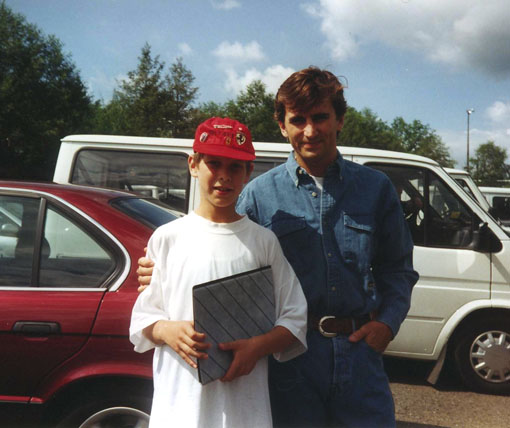

1994 BELGIAN GRAND PRIX
SPA-FRANCORCHAMPS
Alex Zanardi, posing with my son Mathias
One of the most lucid and popular drivers ever to grace an F1 grid, Alex Zanardi's 1999 season with Williams remains one of the all-time great mysteries.
The Italian had sprung from karting into his national F3 series in 1988, and by 1990 had finished a close second in the championship after winning a brace of races. He had tasted F3000 briefly in 1989, but 1991 saw him make his pukka debut with the Il Barone Rampante team. He was a revelation. Fast and uncharacteristically cool for a Latin, he also proved himself to have an uncanny ability not just to detect what a car was doing, but to relate it to his engineers. James Hunt raved about him. That season Zanardi was only narrowly beaten by Christian Fittipaldi to the F3000 title, and made his F1 debut in Spain as Michael Schumacher's replacement at Jordan. Again, his pace in the Japanese GP was a revelation and Jordan raved about him, but Eddie could not afford to run him in 1992. Instead, Zanardi stood in, ironically, for the injured Fittipaldi at Minardi, but suffered two failures to qualify in three races.
The big chance finally came in 1993. Initially he had been testing for Benetton, but Peter Collins snapped him up to replace Mika Hakkinen at Lotus. In only his second race for the team, in Brazil, Zanardi scored what would be the sole point of his F1 career. Little slower than teammate Johnny Herbert, he was an immense asset in trying to sort the team's complex and unreliable active suspension.
During practice for the Belgium Grand Prix, a massive accident at Spa's Eau Rouge, thought to have been caused by a suspension glitch, sidelined him until the Spanish GP the following year, but his return coincided with Lotus' gradual decline. A true team player he did his best, but faced the dole queue in 1995 after Lotus collapsed. That year he raced only once in the Porsche Supercup (he won, at Imola), and in some sportscar races for Lotus, before his strong relationship with Reynard saw him gain the chance to test an IndyCar for Chip Ganassi. It was the beginning of a new dawn that saw him reestablish his career. In 1996 he was the revelation of the CART championship, and in 1997 and 1998 he dominated it with a series of blistering drives on all manner of circuits. By July 1998 he had in his pocket what it appeared most drivers in F1 would have coveted: a three-year contract with Williams.
Paired with Ralf Schumacher, Zanardi proved as quick during pre-season testing, but then it all went wrong. His car was brutally unreliable; his engineer was inexperienced in F1; the team quickly lost faith in him; he seemed preoccupied with his wife's disapproval of racing after the birth of their son, Niccolo. Everyone had a different idea why the man who could charm results from an IndyCar failed to score a single point for Williams, as Ralf Schumacher seemed to do nothing but rack them up. Zanardi himself, ever anxious not to rubbish his team, seemed at a loss to explain why only a handful of his races bore his usual hallmark. The final indignity came when Williams dropped him - for 20 year-old rookie Jenson Button.
Zanardi was paid to sit out the 2000 season and in 2001 signed a deal in America with Mo Nunn Racing. In September that year he had a huge accident in the American Memorial 500 at the Lausitzring in Germany and lost both his legs. He was helicoptered to hospital to Berlin and nearly died from loss of blood but he survived and his recovery was an inspiration to many in the racing business. He returned to the CART scene as a visitor in Toronto in July 2002 and at the end of the year took part in a karting event, driving with artificial limbs.